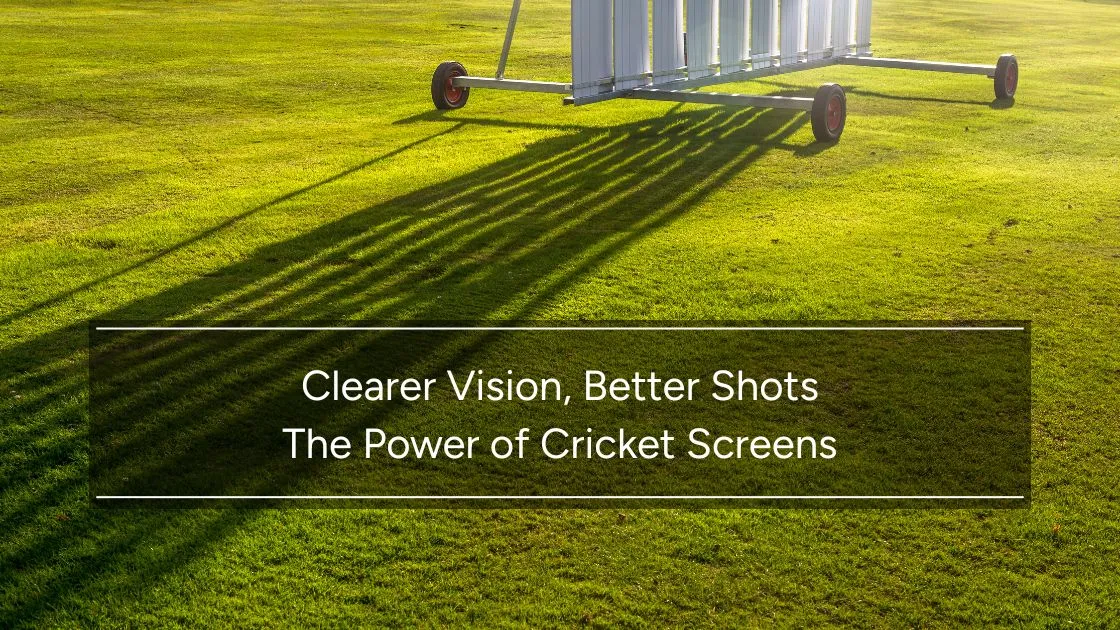 Add My Company
Add My Company

Cricket screens, sometimes called sight screens, are common features of many major cricket grounds. These large flat panels of material are relatively unique for cricket as a sport. Few other ball games feature anything like these masses of wood, mesh, or polymer.
So this naturally invites two questions – “What are they?” and “Why do they matter?”
Whether you are a player, a spectator, a coach, a grounds manager, or just someone interested in cricket in general, Stuart Canvas Group is here to help.
Read on to find out why cricket screens really enhance player performance, deliver gameplay fairness, and make cricket as a whole more fun for everyone.
What is a cricket screen?
A cricket screen is a large set of panels (often wooden, but far from always) positioned around the ground to provide important visual contrast for the batsman.
The colour contrast between the panels and the ball means that when the ball is bowled, the batsman has a clearer view of the ball and its movements. This gives them a better chance to strike the ball accurately when it hits.
Why are they called sight screens?
Because they allow the batsman a clear contrast to get better sight of the ball.
The dark red of the ball contrasts well against the bright white of the panels of the sight screen.
Why are these sight screens so important?
Because of the split-second decision making processes involved in batting a ball in cricket.
Speed bowlers can bowl at around 75 miles per hour. Given that the cricket pitch is just 22 yards long, batsmen have less than a second to angle their strike at the ball.
With such a short window, you need to see the ball as clearly as possible. The contrast offered by the colours cricket sight screen is vital.
What different kinds of cricket sight screens are there?
Many different types.
There are wooden sight screens. These are beautifully crafted and carry the kind of timelessness of cricket’s heyday that adds real authenticity to the atmosphere. They are very durable, but also very weighty, and may need more people to move them in and out of position.
There’s also polypropylene cricket sight screens which offer a lighter and more economical alternative to the wooden options. These are fitted onto a steel frame, and can be moved around more easily by an individual person.
Other options include tracked cricket sight screens which offer an easier way to move the sight screens around the grounds. These can be bespoke built to your exact requirements.
There are also cricket screens made of mesh that can be rolled up and redeployed as and when needed. These can be mounted on rolling metal frames which allows for lightweight and mobile sight screen placements. They can also be or they can be fitted as part of your grounds pavilion allowing for a bespoke built-in option.
What colours do cricket sight screens come in?
Generally speaking cricket screens are either white or black.
This depends on the type of ball being used. Most cricket teams will either use red or white balls. With red balls, white screens offer the batter better contrast. For white balls, black screens are the contrasting colour you need.
How do cricket sight screens change colour?
Sometimes a fabric cover can be placed over a wooden or polymer sight screen to allow the colour to change from white to black or vice versa.
Other times, the screens are mounted on a frame with a rotating panel function, which allows the panels to flip round so that a black or white side is facing the batsman.
Also, mesh sight screens have two sides, so when the rolls are mounted to the frame, their orientation determines the colour.
How do cricket sight screens change the game?
They make the game fairer.
The common expression “that’s not cricket” implies that a situation is somehow unfair or otherwise less than balanced between two or more parties. The game of cricket is meant to be a high watermark of fairness and balance.
The sight screens offer an extra edge of balance to the game of cricket. Without them, the batsmen would have no choice but to be entirely reactionary to the plans and purposes of the fielding / bowling team.
With that little extra visual contrast, the batsmen can plan where they’ll hit. How they will strike. What they will do. This makes the game as a whole much more interesting and exciting.
How do you choose the right cricket sight screen?
There are several different factors to consider.
Staff – Do you have a large and strong grounds staff team? If you do, you’ll be able to move the heavier wooden sight screens more easily. However, if you’ve got a smaller team of volunteers you might need to go for a lighter option like polypropylene or mesh.
Space – Do you have lots of space and security on your grounds? If you do, you might be less concerned about leaving the sight screens out in the open, so a wooden cricket screen or the polypropylene option might be good for you. However, if space is at a premium, it might be wiser to consider the mesh option, which can be put away more easily. Also, space considerations would affect whether you want to use tracked mounting or mobile wheeled frames, such as those found on wooden and polypropylene options.
Colour – Do you only use one colour of ball at your grounds? Then you may not need an option that can change colour. However, if there’s problems with that, a changeable alternative like mesh or flipping panels could be useful.
Budget – What kind of budget are you working with? Bespoke options such as tracked mounting or the pavilion options are definitely worth considering on the market’s premium end. Mesh sight screens and polypropylene are generally less costly than the wooden alternatives.
For the best games of cricket at your club, you need that extra fairness, and the best equipment will let you do that. Speak to Stuart Canvas Group today, and find the best cricket sight screens to meet your needs.
For more information on Clearer Vision, Better Shots: The Power of Cricket Screens talk to Stuart Canvas Group

